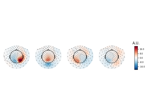mne.time_frequency.psd_array_welch¶
- mne.time_frequency.psd_array_welch(x, sfreq, fmin=0, fmax=inf, n_fft=256, n_overlap=0, n_per_seg=None, n_jobs=1, average='mean', window='hamming', verbose=None)[source]¶
Compute power spectral density (PSD) using Welch’s method.
- Parameters
- x
array, shape=(…, n_times) The data to compute PSD from.
- sfreq
float The sampling frequency.
- fmin
float The lower frequency of interest.
- fmax
float The upper frequency of interest.
- n_fft
int The length of FFT used, must be
>= n_per_seg(default: 256). The segments will be zero-padded ifn_fft > n_per_seg.- n_overlap
int The number of points of overlap between segments. Will be adjusted to be <= n_per_seg. The default value is 0.
- n_per_seg
int|None Length of each Welch segment (windowed with a Hamming window). Defaults to None, which sets n_per_seg equal to n_fft.
- n_jobs
int The number of jobs to run in parallel (default 1). Requires the joblib package.
- average
str|None How to average the segments. If
mean(default), calculate the arithmetic mean. Ifmedian, calculate the median, corrected for its bias relative to the mean. IfNone, returns the unaggregated segments.New in version 0.19.0.
- window
str|float|tuple Windowing function to use. See
scipy.signal.get_window().New in version 0.22.0.
- verbosebool,
str,int, orNone If not None, override default verbose level (see
mne.verbose()and Logging documentation for more). If used, it should be passed as a keyword-argument only.
- x
- Returns
- psds
ndarray, shape (…, n_freqs) or (…, n_freqs, n_segments) The power spectral densities. If
average='meanoraverage='median', the returned array will have the same shape as the input data plus an additional frequency dimension. Ifaverage=None, the returned array will have the same shape as the input data plus two additional dimensions corresponding to frequencies and the unaggregated segments, respectively.- freqs
ndarray, shape (n_freqs,) The frequencies.
- psds
Notes
New in version 0.14.0.
